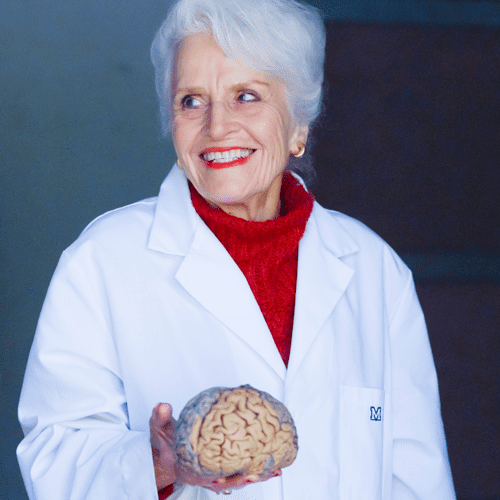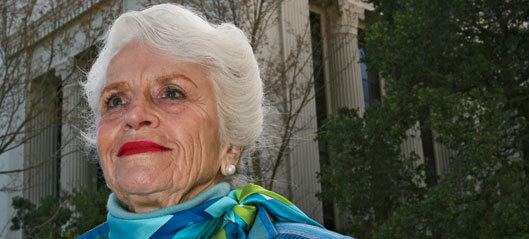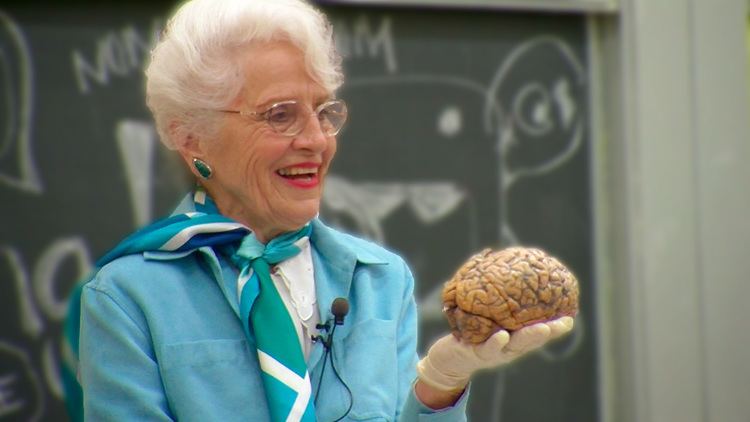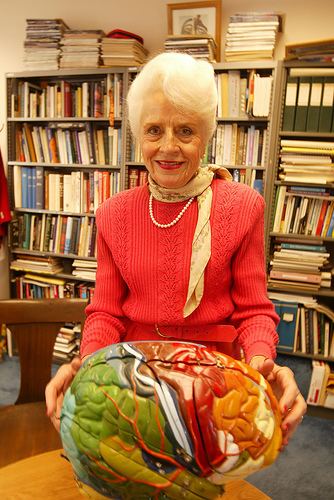Nationality American Name Marian Diamond | Role Professor | |
 | ||
Alma mater University of California, BerkeleyUniversity of Oslo Thesis Functional Interrelationships of the Hypothalamus and the Neurohypophysis (1953) Notable awards The Distinguished Senior Woman Scholar in America awarded by the American Association of University Women Spouse Richard Martin Diamond (1950-1979 div.)Arnold Bernard Scheibel (1982-present) Parents Rosa Marian Wamphler Cleeves Books The Human Brain Coloring Book Education University of California, Berkeley (1953), University of California, Berkeley Died July 25, 2017 (aged 90) Oakland, California Similar Mark Rosenzweig, James McGaugh, Marc Breedlove | ||
Integrative biology 131 lecture 01 organization of body
Marian Diamond (née Cleeves; November 11, 1926 – July 25, 2017) was a professor emerita of anatomy at the University of California, Berkeley who had published research into the neuroanatomy of the forebrain, notably the discovery of the impact of the surrounding environment on brain development, differences between the cerebral cortex of male and female rats, and the link between positive thinking and immune health.
Contents
- Integrative biology 131 lecture 01 organization of body
- Integrative biology 131 lecture 02 skeletal system
- Early life
- Career
- Personal life
- Documentary film
- Contributions to neuroscience neuroanatomy neuroplasticity
- Awards
- References

Integrative biology 131 lecture 02 skeletal system
Early life

Marian Cleeves was born in Glendale, California to Dr. Montague Cleeves and Rosa Marian Wamphler Cleeves as the sixth and last child in the family. Her father was an English physician and her mother a Latin teacher at Berkeley High School. Diamond grew up in La Crescenta. She was educated with her siblings near home at La Crescenta grammar school, Clark Junior High, Glendale High School and finally Glendale Community College, before going to University of California, Berkeley. She played tennis at Berkeley, earning a letter.
Career

After graduating with a bachelor's degree in 1948, Diamond spent a summer at the University of Oslo, Norway before returning to Berkeley for her graduate studies, the first female graduate student in the department of Anatomy. Her doctoral dissertation thesis "Functional Interrelationships of the Hypothalamus and the Neurohypophysis" was published in 1953.

During her PhD degree, Diamond also began to teach, and teaching became a lifelong passion that continued well into her eighties. Marian Diamond received her PhD degree in human anatomy. After working as a research assistant at Harvard University between 1952–53, Diamond became the first woman science instructor at Cornell University from 1955-58 where she taught human biology and comparative anatomy. Diamond returned to the University of California, Berkeley in 1960 in the role of lecturer. She joined an ongoing research project with psychologists David Krech, Mark Rosenzweig, and chemist Edward Bennett, as a neuroanatomist.

By 1964, Diamond had the data and the first actual evidence in anatomical measurements "showing the plasticity of the anatomy of the mammalian cerebral cortex." These stunning results put brain plasticity on the map and, as Diamond wrote in 2009, "opened the doors for our experiments to follow for the next 37 years."

UC Berkeley invited Diamond to be an Assistant Professor in 1965, later welcoming her as a full professor, and later Professor Emeritus until her death in 2017. 1984 brought a new and difficult, although desired, challenge to the Diamond lab. Diamond and her associates had the "privilege of access to sufficient tissue from Einstein's brain" to make the first ever analysis of his preserved brain, followed by publication of their research. The 1985 publication of "On the Brain of a Scientist: Albert Einstein" created some controversy in academia over the role of glial cells. However, it also ushered in an exciting new era of interest in neuroglia.
Personal life

Diamond married Richard Martin Diamond in 1950 and they had four children: Catherine Theresa (1953), Richard Cleeves (1955) Jeff Barja (1958) and Ann (1962). They divorced in 1979 after which Diamond married Professor Arnold Bernard Scheibel in 1982.
Documentary film
My Love Affair with the Brain: The Life and Science of Dr. Marian Diamond is a 2016 award-winning documentary about Dr. Diamond's life as a pioneering woman of science, her curiosity and passion for the human brain, as well as her research and love of teaching.
Contributions to neuroscience, neuroanatomy, neuroplasticity
Neuroplasticity: Diamond was a pioneer in anatomical neuroscience whose major scientific contributions have changed forever how we view the human brain. Diamond produced the first scientific evidence of anatomical neuroplasticity in the early 1960s. At that time, the scientific consensus was that the nature of your brain was due to genetics and was unchangeable and fixed. Diamond showed that the structural components of the cerebral cortex can be altered by either enriched or impoverished environments at any age, from prenatal to extremely old age. Her initial anatomical experiment, and replication experiments, with young rats showed that the cerebral cortex of the enriched rats was 6% thicker than the cortex of the impoverished rats based on different kinds of early life experiences. An enriched cortex shows greater learning capacity while an impoverished one shows lesser learning capacity. These paradigm-changing results, published in 1964, helped to launch modern neuroscience.
Einstein's Brain: In early 1984, Diamond received four blocks of the preserved brain of Albert Einstein from Thomas Stoltz Harvey. Harvey, pathologist of Princeton Hospital at the time of Einstein's death, had removed Einstein's brain during autopsy in 1955 and maintained personal possession of the brain. The fact that the Einstein brain tissue was already embedded in celloidin when the Diamond lab received it meant that their choice of methods of examination would be somewhat limited. However, they were able to successfully analyze both the superior prefrontal (area 9) and inferior parietal (area 39) association cortices of the left and right hemispheres of Einstein's brain and compare results with the identical regions in the control base of 11 human, male, preserved brains. From previous analysis of the eleven control brains, the Diamond lab "learned the frontal cortex did have more glial cells/neuron than the parietal cortex." After many years of research, Diamond and her team had data proving that, in the rat brain, glial cells increased with enriched conditions, but did not increase with age. Diamond and her associates discovered that the big difference in all four areas was in nonneuronal cells. Einstein had more glial cells per neuron than the average male brains of the control group. Importantly, the biggest difference was found in area 39 of the left hemisphere of Einstein's brain where the increase in the number of glial cells per neuron was statistically significantly greater than in the control brains. Astrocyte and oligodendrocyte glial cells were pooled for these results.
Diamond demonstrated that the structural arrangement of the male and female cortices is significantly different and can be altered in the absence of sex steroid hormones.
Diamond also showed that the dorsal lateral frontal cerebral cortex is bilaterally deficient in the immune deficient mouse and can be reversed with thymic transplants. In humans, cognitive stimulation increases circulating CD4-positive T lymphocytes, supporting the idea that immunity can be voluntarily modulated, in other words, that positive thinking can impact the immune system.
